Complete Solutions to Resistivity And Drift Velocity of chapter CURRENT ELECTRICITY of Class 12 book with complete answers and questions
| Class 12 | PHYSICS |
| Chapter | CURRENT ELECTRICITY |
| A2Z | Resistivity And Drift Velocity |
| Number Of Questions | 47 |
| Academic Year | 2023-24 |
On increasing the temperature of a conductor, its resistance increases because
View SolutionThe relaxation time in conductors
View SolutionDrift velocity `v_(d)` varies with the intensity of electric field as per the relation
View SolutionA potential difference of `V` applied at the ends of a copper wire of length `l` and diameter `d`. On doubling only `d` drift velocity.
View SolutionA current `I` is passing through a wire having two sections `P` and `O` of uniform diameters `d` and `d//2` respectively. If the mean drift velocity of electrons in section `P` and `Q` is denoted by `v_(P)` and `v_(Q)` respectively, then
View Solution`E` denotes electric field in a uniform conductor, `I` corresponding current through it, `v_(d)` velocity of electrons and `P` denotes thermal power produced in the conductor, then which of the following graph is incorrect?
View SolutionThe resistivity of iron is `1 xx 10^(-7)` ohm -m. The resistance of a iron wire of particular length and thickness is 1 ohm. If the length and the diameter of wire both are doubled, then the resistivity in ohm-m will be
View SolutionThe temperature coefficient of resistance of a wire is `0.00125 ^(@)C^(-1)`. At 300K, its resistance is 1 `Omega`. The resistance of the wire will be 2 `Omega` at
View SolutionWhen the length and area of cross-section both are doubled, then its resistance
View SolutionThe resistance of a wire is `20 ohm`. It is so stretched that the length becomes three times, then the new resistance of the wire will be
View SolutionThe specific resistance of a wire is `rho`, its volume is `3 m^(3)` and its resistance is `3 ohms`, then its length will be
View Solution`62.5 xx 10^(18)` electrons per second are flowing through a wire of area of cross-section `0.1 m^(2)`, the value of current flowing will be
View SolutionIn an electrolyte `3.2 xx 10^(18)` bivalent positive ions drift to the right per second while `3.6 xx 10^(18)` monovalent negaitve ions drift to the per second. Then the current is
View SolutionAn ionization chamber with parallel conducting plates as anode and cathode has `5 xx 10^(7)` electrons and the same number of singly-charged positive ions per `cm^(3)`. The electrons are moving towards the anode with velocity `0.4 m//s`. The current density from anode to cathode is `4 mu A//m^(2)`. The velocity of positive ions moving towards cathode is
View SolutionThere is a current of 1.344 amp in a copper wire whose area of cross-section normal to the length of the wire is `1 mm^(2)`. If the number of free electrons per `cm^(2)` is `8.4 xx 10^(22)` then the drift velocity would be
View SolutionThe resistance of a wire is `10 Omega`. Its lengthis incrased by `10%` by stretching. The new resistance will now be
View SolutionResistance of tungsten wire at `150^(@)C` is `133 Omega`. Its resistance temperature coefficient is `0.0045//^(@)C`. The resistance of this wire at `500^(@)C` will be
View SolutionA copper wire of length `1 m` and radius is joined in series with an iron wire of length `2 m` and radius `3 mm` and a current is passed through the wire. The ratio of the current density in the copper and iron wires is
View SolutionIf the resistance of a conductor is `5 Omega` at `50^(@)C` and `7Omega` at `100^(@)C` then the mean temperature coefficient of resistance of the material is
View SolutionIn a neon discharge tube `2.9 xx 10^(18) Ne^(+)` ions move to the right each second while `1.2 xx 10^(18)` eletrons move to the left per second. Electron charge is `1.6 xx 10^(-9) C`. The current in the discharge tube
View SolutionDimensions of a block are `1 cm xx 1 cm xx 10 cm`. If specific resistance of its material is `3 xx 10^(-7)`ohm-m, then the resistance between the opposite rectangular faces is
View SolutionIn an electrical cable there is a single wire of radius `9 mm` of copper. Its resistance is `5 Omega`. The cable is replaced by 6 different insulated copper, wires the radius of each wire is `3 mm`. Now the total resistance of the cable will be
View SolutionTwo wires `A` and `B` of same material and same mass have radius `2r` and `r`. If resistance of wire `A` is `34 Omega`, then resistance of `B` will be
View SolutionTwo rods of same material and length have their electric resistance in ratio `1 : 2`. When both rods are dipped in water, the correct statement will be
View SolutionThe resistance of a wire is 5 ohm at `50^@C` and 6 ohm at `100^@C`. The resistance of the wire at `0^@C` will be
View SolutionA rod of certain metal is `1.0 m` long and `0.6 cm` in diameter. Its resistance is `3.0 xx 10&(-3)` ohm. Another disc made of the same metal is `2.0 cm` in diameter and `1.0 mm` thick. What is the resistance between the round faces of the disc?
View SolutionMasses of 3 wires of same metal are in the ratio `1 : 2 : 3` and their lengths are in the ratio `3 : 2 : 1`. The electrical resistances are in ratio
View SolutionThe length of a given cylindrical wire is increased by `100%`. Due to the consequent decrease in diameter the change in the resistance of the wire will be
View SolutionA thick wire is stretched so that its length become two times. Assuming that there is no change in its density, then what is the ratio of change in resistance of wire to in initial resistance of wire
View SolutionThe length of the resistance wire is increased by `10%`. What is the corresponding change in the resistance of wire?
View SolutionCurrent flows through a metallic conductor whose area of cross-section increases in the direction of the current. If we move in this direction.
View SolutionA current `I` flows through a uniform wire of diameter `d` when the mean electron drift velocity is `v`. The same current will flow though a wire of diameter `d//2` made of the same material if the mean drift velocity of the electron is
View SolutionA wire has non-uniform cross-section as shown in fig. steady current flows through it. The drift speed of electrons at point `P` and `Q` is `v_(P)` and `v_(Q)`
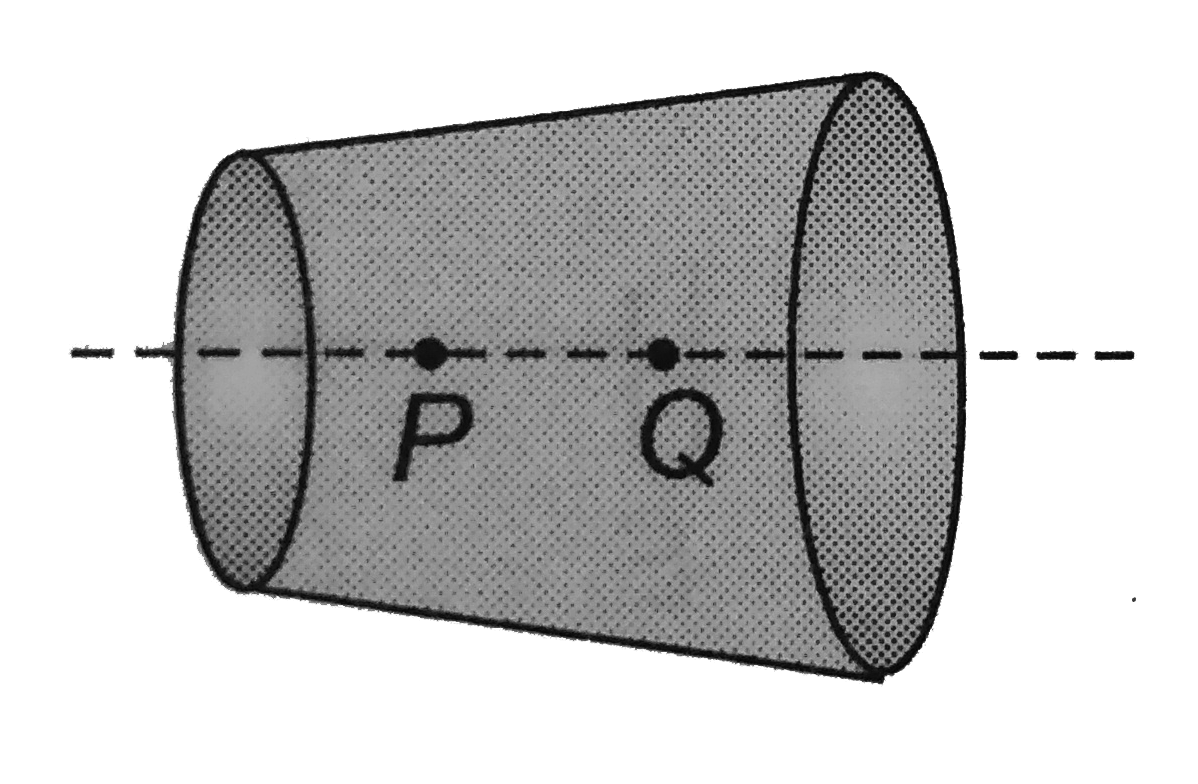
View SolutionAn insulating pipe of cross-sectional area `A` contains an electrolyte which has two types of ions: their charges being `-e` and `+ 2e`. A potential difference applied between the ends of the pipe result in the drifting of the two types of ions, having drift speed `= v` (- ve ion) and `v//4` (+ ve ion). Both ions have the same number per unit volume `= n`. The current flowing through the pipe is
View SolutionTwo cylindrical rods of uniform cross-section area `A` and `2A`, having free electrons per unit volume `2n` and `n` respectively are joined in series. A current `I` flows through them in steady state. Then the ratio of drift velocity of free electron in left rod to drift velocity of electron in the
right rod is `((v_(L))/(v_(R)))` is
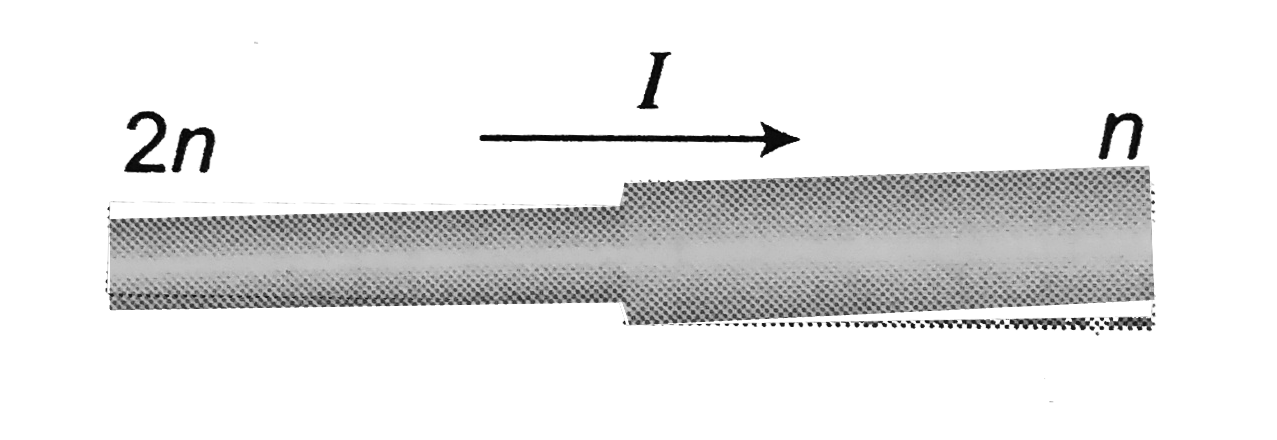
View SolutionA current `I` flows through a cylindrical rod of uniform cross-section area `A` and resistivity `rho`. The electric flux through the shaded cross-section of the rod as shown in figure is
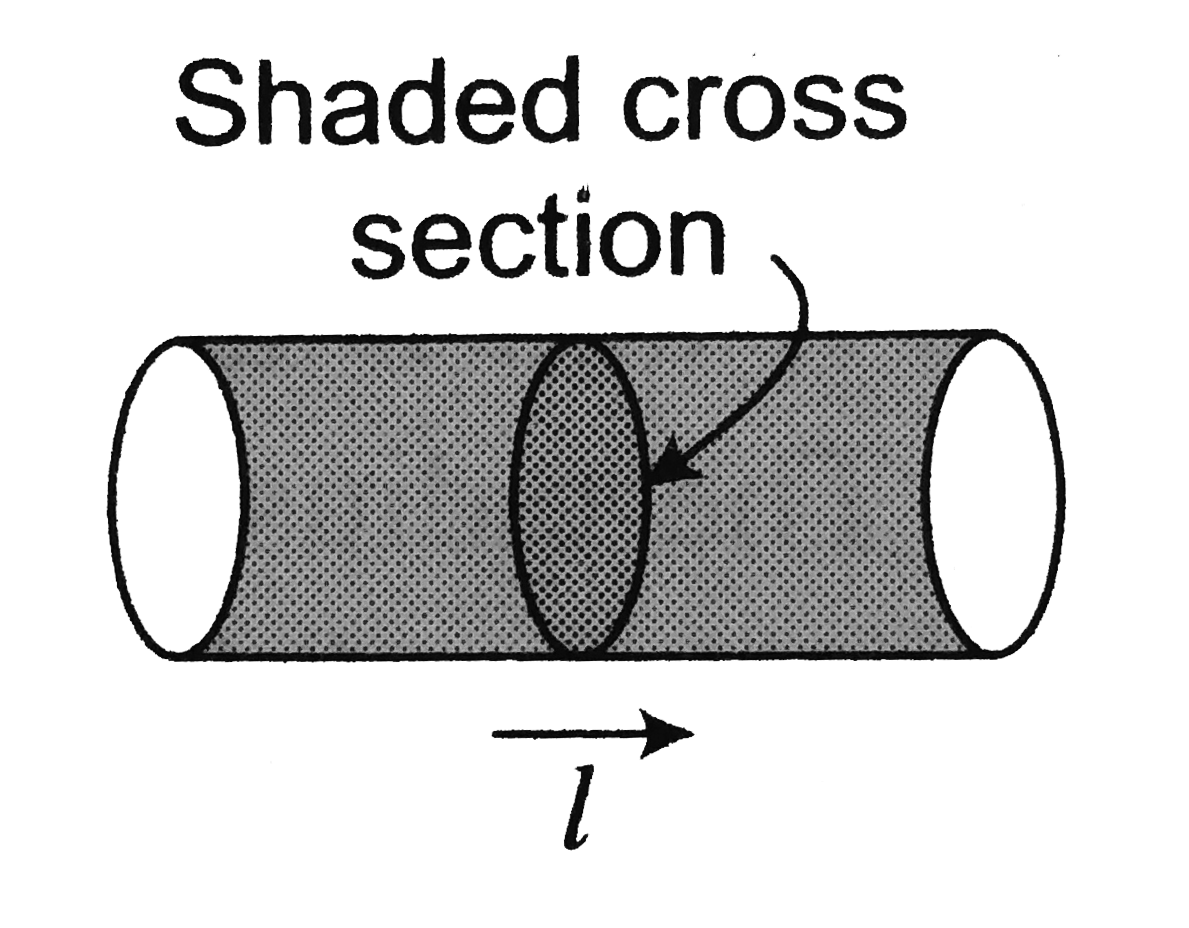
View SolutionA electric current passes through non uniform cross-section wire made of homogeneous and isotropic meterial. If the `j_(A)` and `J_(B)` be the current densities and `E_(A)` and `E_(B)` be the electric field intensities at `A` and `B` respectively, then
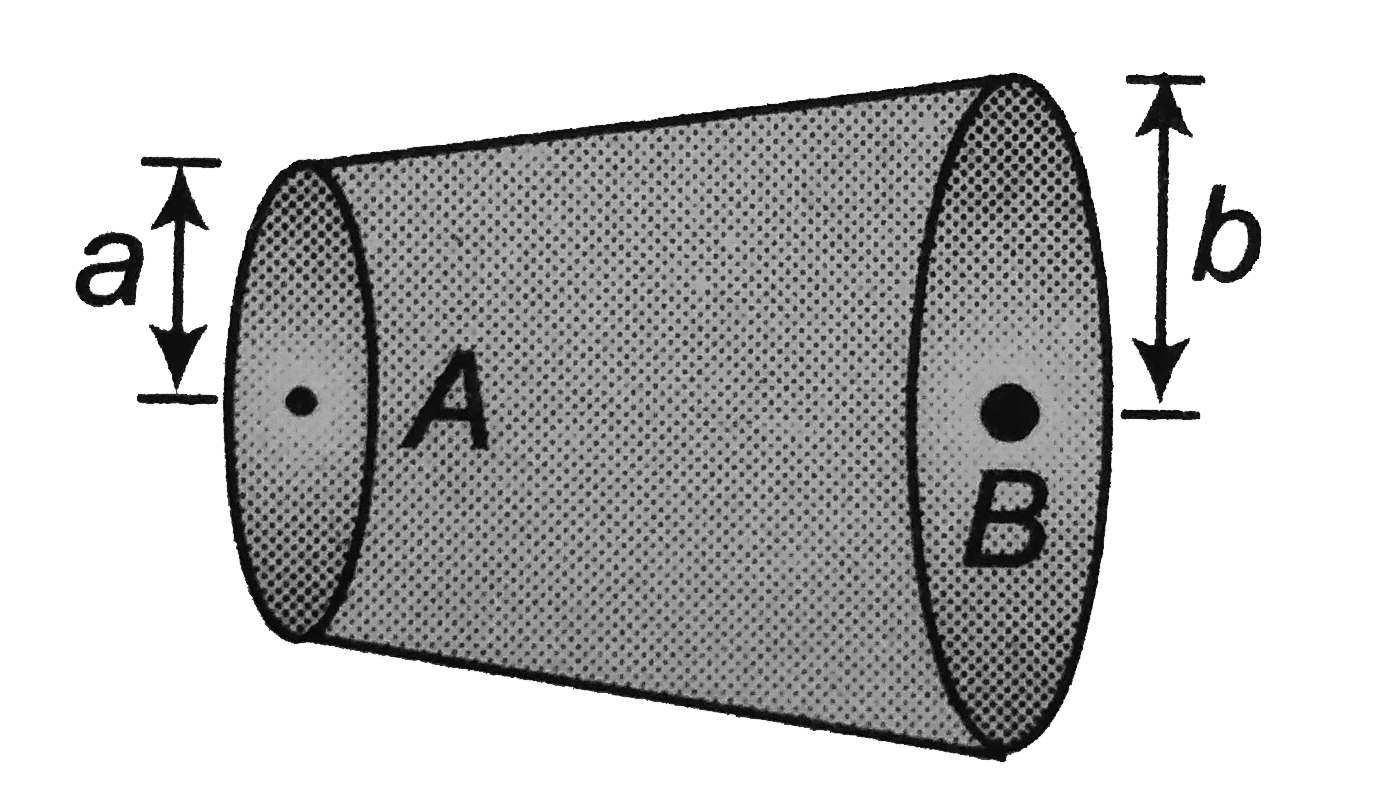
View SolutionAn electric current flows along an insulated strip `PQ` of a metallic conductor. The current density in the strip varies as shown in the graph. Which one of the following statement could explain this variation?
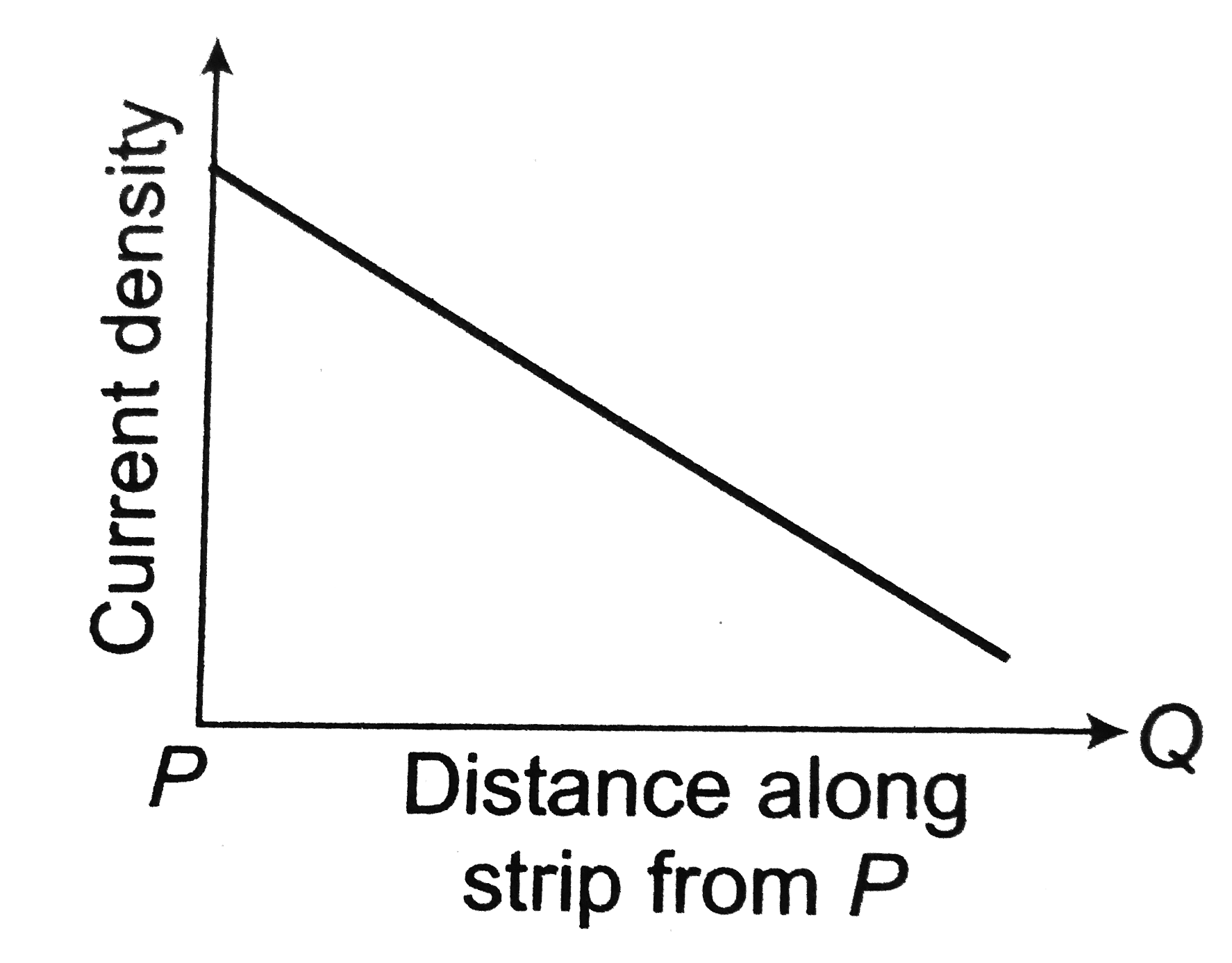
View SolutionA wire of cross-section area `A`, length `L_(1)`, resistivity `rho_(1)` and temperature coefficient of resistivity `alpha_(1)` is connected in series to a second wire of length `L_(2)`, resistivity `rho_(2)` temperature coefficient of resistivity `alpha_(2)` and the same area `A`, so that wires carry same current. Total resistance `R` is independent of temperature for small temperature change if (Thermal expansion effect is negligible)
View SolutionLength of a hollow tube is `5 m`, its outer diameter is `10 cm` and thickness of its wall is `5 mm`. If resistivity of the material of the tube is `1.7 xx 10^(-8) Omega xx m`, then resistance of tube will be
View SolutionTwo uniform wires A and B of same metal and have equal masses, the radius of wire A is twice that of wire B. The total resistance of A and B when connected in parallel is
View SolutionFollowing figure shows cross-section through three long conductors of the same length and material, with square cross-section of edge lengths as shown. Conductor `B` will snugly within conductor `B`. Relationship between their end to end resistance is
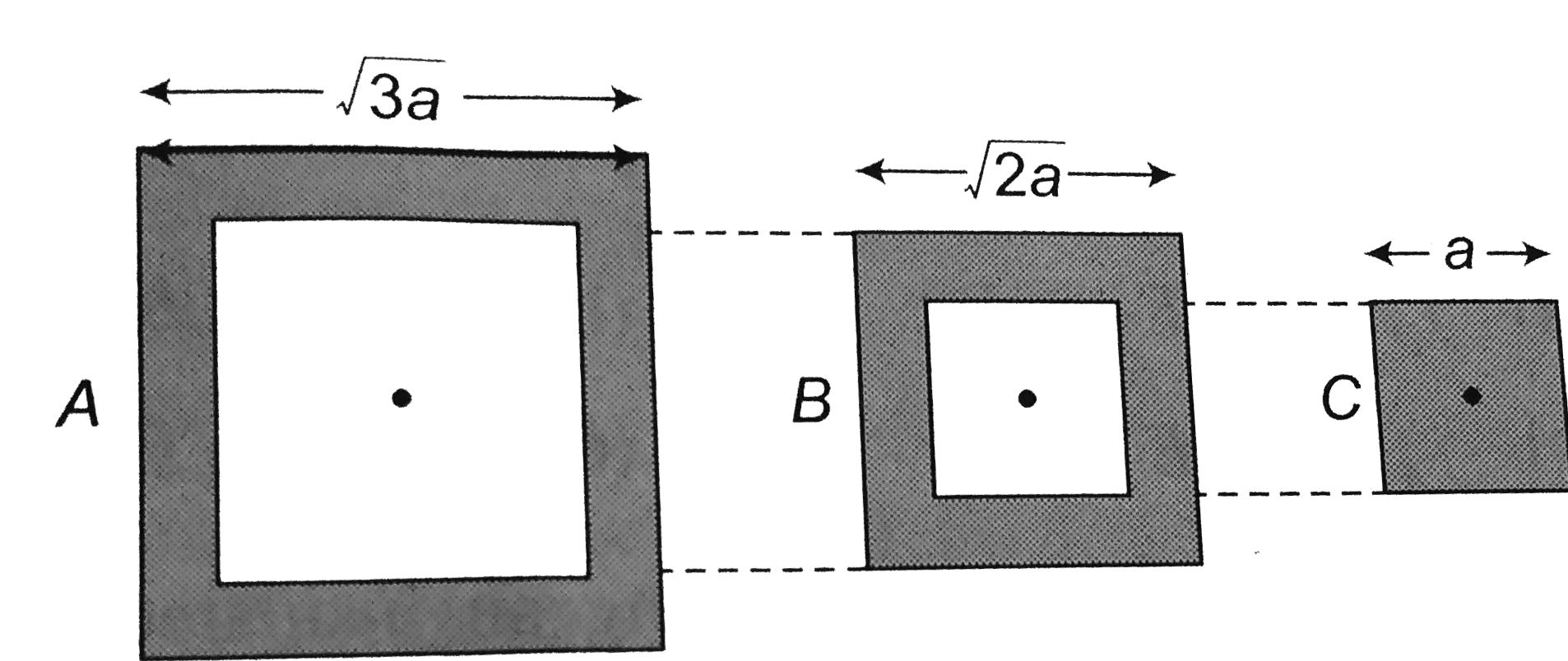
View SolutionTwo resistance `R_(1)` and `R_(2)` are made of different material. The temperature coefficient of the material of `R_(1)` is `alpha` and of the material of `R_(2)` is `-beta`. Then resistance of the series combination of `R_(1)` and `R_(2)` will not change with temperature, if `R_(1)//R_(2)` will not change with temperature if `R_(1)//R_(2)` equals
View SolutionTwo wires of resistance `R_(1)` and `R_(2)` have temperature coeficient of resistance `alpha_(1)` and `alpha_(2)` respectively. These are joined in series. The effeictive temperature coefficient of resistance is
View Solution`I-V` characteristics of a copper wire of length `L` and area fo cross-section `A` is shown in Fig. The slope of the curve becomes
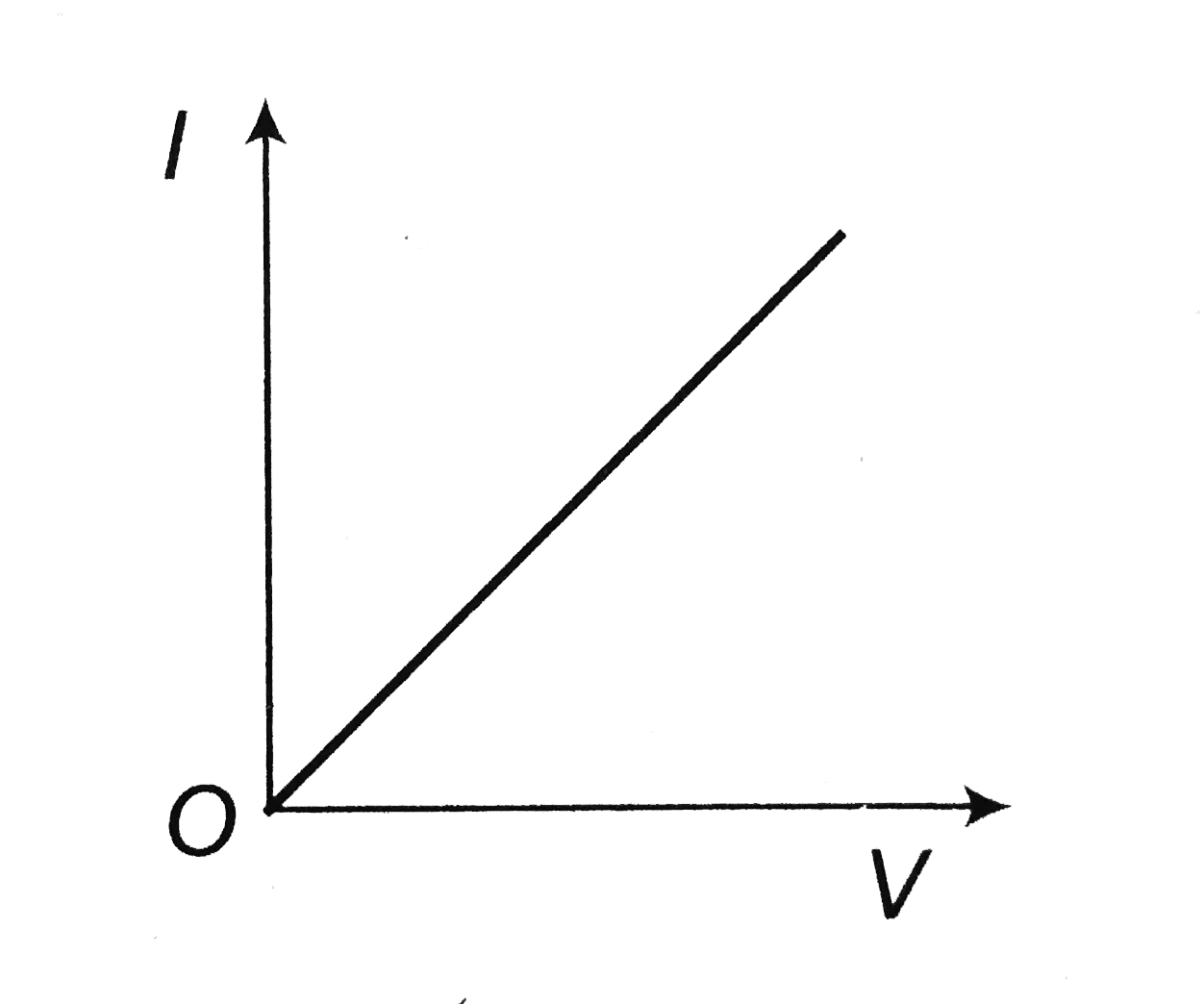
View SolutionTwo resistors of resistance `R_(1)` and `R_(2)` having `R_(1) gt R_(2)` are connected in parallel. For equivalent resistance R, the correct statement is
View SolutionA wire of resistance `R` is divided in 10 equal parts. These parts are connected in parallel, the equivalent resistance of such connection will be
View Solution
Resistivity And Drift Velocity questions and complete solutions for chapter CURRENT ELECTRICITY of A2Z PHYSICS (HINGLISH) of Class 12
All Exercises from A2Z Class 12 PHYSICS CURRENT ELECTRICITY
- AIIMS Questions
- AIPMTNEET Questions
- Ammeter And Voltmeter
- Assertion- Reason
- Combination And Resistivity
- Heating Effect Of Current
- Kircoff'S Laws And Simple Circuits
- Potentiometer And Meter Bridge
- Problems Based On Mixed Concepts
- R-C Circuits
- Resistivity And Drift Velocity
- Section - A
- Section - C
- Section B - Assertion Reasoning
- Section D - Chapter End Test